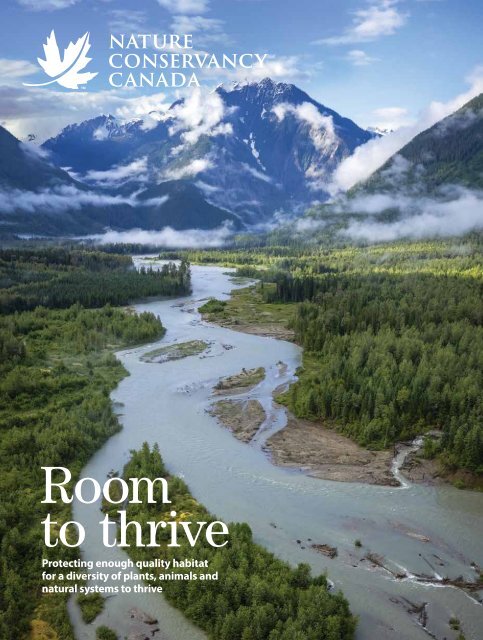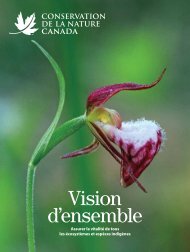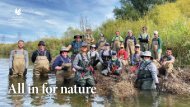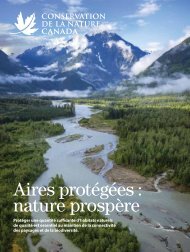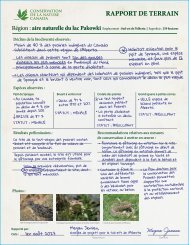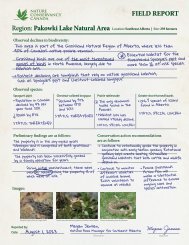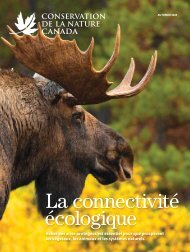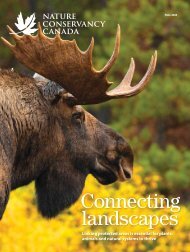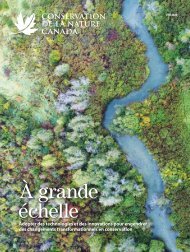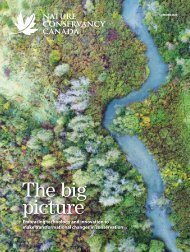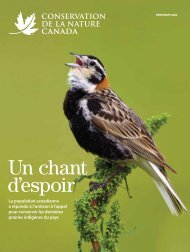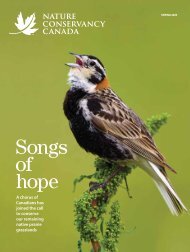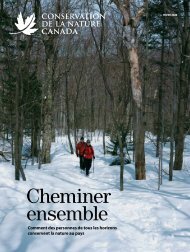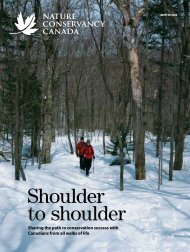NCC Magazine Winter 2024
You also want an ePaper? Increase the reach of your titles
YUMPU automatically turns print PDFs into web optimized ePapers that Google loves.
Room<br />
to thrive<br />
TKTKTKTKTKTKT<br />
Protecting enough quality habitat<br />
for a diversity of plants, animals and<br />
natural systems to thrive<br />
natureconservancy.ca<br />
WINTER 2021 1
WINTER <strong>2024</strong><br />
CONTENTS<br />
Nature Conservancy of Canada<br />
4 Nature knows no bounds<br />
<strong>NCC</strong> has partnered with Parks Canada to<br />
bolster conservation near national parks.<br />
6 Ghost Horse Hills<br />
Embrace the frosty magic of the season<br />
with a captivating hike in this winter<br />
playground north of Edmonton.<br />
7 <strong>Winter</strong>’s avian<br />
allure unveiled<br />
<strong>Winter</strong> is a great time to learn the<br />
basics of birding.<br />
7 Dream catcher<br />
Colin Campbell’s backpack carries the<br />
memories of his family’s connection to<br />
nature, and to each other.<br />
8 Room to thrive<br />
Protecting appropriate habitat in<br />
adequate amounts is essential<br />
to providing connected landscapes<br />
that support biodiversity.<br />
12 Mule deer<br />
This member of the Cervidae family<br />
is named for its large, mule-like ears.<br />
14 Project updates<br />
Enhancing biodiversity in SK; advancing<br />
Reconciliation in MB; partnership<br />
with Qalipu First Nation; <strong>NCC</strong> on the<br />
world stage.<br />
16 Visual impact<br />
Photographer Mike Dembeck connects<br />
our hearts to nature through his images.<br />
18 Weaving nature into art<br />
Art inspired by nature, with the land and<br />
sustainability at its core.<br />
Digital extras<br />
Check out our online magazine page with<br />
additional content to supplement this issue,<br />
at nccmagazine.ca.<br />
Nature Conservancy of Canada<br />
365 Bloor Street East, Suite 1501<br />
Toronto, Ontario, Canada M4W 3L4<br />
magazine@natureconservancy.ca | Phone: 416.932.3202 | Toll-free: 877.231.3552<br />
The Nature Conservancy of Canada (<strong>NCC</strong>) is the country’s unifying force for nature. We seek<br />
solutions to the twin crises of rapid biodiversity loss and climate change through large-scale,<br />
permanent land conservation. <strong>NCC</strong> is a registered charity. With nature, we build a thriving world.<br />
The Nature Conservancy of Canada <strong>Magazine</strong> is distributed to donors and supporters of <strong>NCC</strong>.<br />
TM<br />
Trademarks owned by the Nature Conservancy of Canada.<br />
FSC® is not responsible for any calculations<br />
on saving resources by choosing this paper.<br />
Printed in Canada with vegetable-based inks by Warrens Waterless Printing.<br />
This publication saved 31 trees and 30,668 litres of water*.<br />
CREATED BY: CALCULATEUR.ROLLANDINC.COM. PHOTO: DENIS DUQUETTE. COVER: PAUL ZIZKA (INCOMAPPLEUX VALLEY, BC).<br />
*<br />
2 WINTER <strong>2024</strong> natureconservancy.ca
Musquash Estuary<br />
Nature Reserve, NB.<br />
Featured<br />
Contributors<br />
MARIE-MICHELE ROUSSEAU-CLAIR: ETIENNE BOISVERT.<br />
Dear friends,<br />
Being in nature provides me with a sense of harmony<br />
and wholeness; it’s part of what I need to thrive. In fact,<br />
I chose the city where I live based on its proximity to<br />
nature and protected areas, including La Mauricie National Park and<br />
adjacent Nature Conservancy of Canada (<strong>NCC</strong>) projects. I love to<br />
spend time in these places and reflect on how elements of the CARE<br />
principle (Connected, Adequate, Representative and Effective) are<br />
at work to make nature more resilient to the impacts of biodiversity<br />
loss and climate change.<br />
The national park, as you’ll learn on page 4, is also part of an<br />
exciting new partnership between Parks Canada and <strong>NCC</strong> to bolster<br />
conservation across the country. It contributes to providing suitable<br />
habitat for at-risk eastern wolves. In complement, <strong>NCC</strong>’s projects<br />
adjacent to the park protect habitat for wood turtles. Together, the<br />
area is made more resilient through the connectedness and variety<br />
of quality habitats, as well as knowledge sharing and collaboration<br />
between the two organizations.<br />
In this issue, we delve into the A of CARE in our four-part<br />
series: understanding the importance of protecting enough of<br />
every habitat for species, natural processes and cultural aspects<br />
to persist through time. As Iryn Tushabe explores in the feature<br />
story, adequacy goes hand in hand with connectivity to achieve<br />
a network of quality habitats for life to thrive.<br />
I hope you will be inspired by the examples of conservation in<br />
this issue that embrace adequacy and see the opportunities for<br />
more great work from coast to coast. Thank you for your continued<br />
support of Canada’s nature.<br />
Yours in conservation,<br />
Marie-Michele Rousseau-Clair<br />
Marie-Michele Rousseau-Clair<br />
Chief conservation officer<br />
Iryn Tushabe<br />
is a Ugandan-Canadian<br />
writer and journalist<br />
now living in Regina,<br />
Saskatchewan. Her work<br />
has been nominated for<br />
numerous awards. Her<br />
debut novel, Everything<br />
is Fine Here, is forthcoming<br />
with House of<br />
Anansi press in winter<br />
2025. She wrote “Room<br />
to thrive,” page 8.<br />
Aaron McKenzie<br />
Fraser is a professional<br />
editorial, commercial<br />
& industrial photographer<br />
based in<br />
Halifax. He specializes<br />
in location-based<br />
environmental<br />
portraits for magazines<br />
and advertising.<br />
Aaron photographed<br />
Mike Dembeck for<br />
“Visual impact,”<br />
page 16.<br />
natureconservancy.ca<br />
WINTER <strong>2024</strong> 3
COAST TO<br />
COAST<br />
2<br />
1<br />
Nature<br />
knows<br />
3<br />
4<br />
no bounds<br />
5<br />
<strong>NCC</strong> has partnered with Parks Canada to<br />
bolster conservation near national parks<br />
6<br />
Birders’ paradise, picturesque summits, soul-soothing<br />
forests, seaside vistas and rolling prairies…Canada’s<br />
national parks and national park reserves teem with life.<br />
The survival of the plants and animals living in these natural<br />
enclaves, however, depends on connected and intact natural<br />
spaces beyond park borders. Yet the landscapes that bring us<br />
these gems are under threat from climate change and biodiversity<br />
loss, and strained by human activity and development.<br />
A new partnership between the Nature Conservancy of Canada<br />
(<strong>NCC</strong>) and Parks Canada (PC) will support healthy and resilient<br />
landscapes across the country.<br />
The Landscape Resiliency Program, a $30-million initiative,<br />
was launched in October 2023. PC will contribute $15 million to<br />
the project, with <strong>NCC</strong> raising another $15 million. <strong>NCC</strong> will work<br />
with Indigenous Nations, local communities, property owners<br />
and partners to support area-based conservation near several<br />
PC parks or reserves. The goal is to conserve 30,000 hectares by<br />
2026. Explore these special places and the species they sustain.<br />
Learn more at natureconservancy.ca/resiliency.<br />
1. Gulf Islands<br />
National Park Reserve<br />
Nestled off Vancouver Island’s<br />
southeastern coast, the Gulf Islands<br />
National Park Reserve protects islets<br />
and coastal landscapes. Seals, otters,<br />
orcas and salmon swim in the waters<br />
of the Salish Sea, while seabirds and<br />
eagles fly above. <strong>NCC</strong> has supported<br />
conservation in the Gulf Islands since<br />
the 1980s. The Salish Sea Natural Area<br />
is crucial to the migration of many<br />
species, including at-risk western<br />
grebes. Most recently, <strong>NCC</strong> secured<br />
Reginald Hill on Salt Spring Island<br />
and Edith Point on Mayne Island, both<br />
of which protect significant stands of<br />
mature coastal Douglas-fir forest.<br />
2. Kootenay National Park<br />
British Columbia is a gift to nature<br />
lovers; the stunning landscapes here<br />
just keep on giving. And Kootenay<br />
National Park is no exception. This<br />
Rocky Mountain gem is a haven for<br />
diverse wildlife, like moose, grizzly<br />
bear, black bear and Canada lynx.<br />
Home to 29 endangered species, it<br />
features open forests and grasslands.<br />
Since the 1990s, <strong>NCC</strong>’s efforts in the<br />
area have enhanced connectivity and<br />
restored vital habitats, especially at<br />
Thunder Hill Ranch, Marion Creek<br />
Benchlands and Luxor Linkage.<br />
1: FERNANDO LESSA; 2: THOMAS DRASDAUSKIS; 3: BRENT CALVER; 4: JASON BANTLE;<br />
5: ADAM BIALO/KONTAKT FILMS; 6: BRIANNE CURRY/<strong>NCC</strong> STAFF.<br />
4 WINTER <strong>2024</strong> natureconservancy.ca
7: <strong>NCC</strong>; 8: <strong>NCC</strong>; 9: ANDREW HERYGERS/<strong>NCC</strong> STAFF; 10: MIKE DEMBECK.<br />
7<br />
8<br />
3. Waterton Lakes<br />
National Park<br />
The magic of Waterton Lakes<br />
National Park occurs where four<br />
unique ecosystems converge. Aptly<br />
named “nature’s meeting place,” it is<br />
a haven for diverse wildlife. Next to<br />
the park lies the Rocky Mountain<br />
Front region, where species like elk<br />
migrate between the mountains and<br />
the foothills grasslands. In 1997, <strong>NCC</strong><br />
and the Weston Family Foundation<br />
jointly launched the Waterton Park<br />
Front Project, a 12,950-hectare<br />
conservation initiative that changed<br />
the course of Canadian conservation<br />
by providing the template for<br />
multiple landscape-scale projects<br />
funded by the Foundation.<br />
9<br />
10<br />
4. Grasslands<br />
National Park<br />
Nature takes centre stage at<br />
Grasslands National Park in southwest<br />
Saskatchewan. Here, the province’s<br />
largest remaining tracts of native<br />
grasslands are home to iconic species<br />
like pronghorn, swift fox and<br />
ferruginous hawk. Visitors may spot<br />
at-risk loggerhead shrikes spearing<br />
their prey on thorns and spikes, or<br />
burrowing owls peeping up from<br />
badger holes. Thanks to more than<br />
25 years of community collaboration,<br />
<strong>NCC</strong> has protected vital natural areas<br />
like Old Man on His Back Prairie and<br />
Heritage Conservation Area, Wideview<br />
Complex and Rangeview for critters<br />
of all shapes and sizes to thrive.<br />
5. Bruce Peninsula<br />
National Park<br />
Bruce Peninsula National Park’s<br />
renowned aquamarine waters hug<br />
the Saugeen Bruce Peninsula and<br />
will have visitors wondering whether<br />
they’re in the Caribbean. The<br />
escarpment’s shoreline caves boast<br />
a bouquet of biodiversity, from<br />
gastropods to hibernating bats.<br />
While marvelling at the marshes,<br />
meadows, alvars and sandy shores,<br />
remember that this area supports<br />
globally rare species, including over<br />
50 species at risk. Since 2014, <strong>NCC</strong><br />
has worked alongside the Saugeen<br />
Ojibway Nation to ensure the<br />
peninsula continues to thrive for<br />
future generations by protecting<br />
habitats, monitoring species at risk,<br />
managing invasive species and more.<br />
6. Point Pelee<br />
National Park<br />
At the southern tip of mainland<br />
Canada lies Point Pelee National Park.<br />
The Carolinian Life Zone, which contains<br />
this tiny slice of Canada, supports<br />
2,200 plant species and over half of<br />
the country’s bird species. It’s also<br />
where rare snails hang out — the<br />
unsung heroes of nutrient recycling.<br />
But “outrunning” environmental<br />
threats for these snails would be quite<br />
the challenge. That’s why habitat<br />
protection is vital for their survival.<br />
<strong>NCC</strong> and its partners have been<br />
working in the surrounding area since<br />
2000, protecting and enriching this<br />
unique haven, ensuring local species<br />
continue to thrive and work their<br />
ecological magic.<br />
7. Thousand Islands<br />
National Park<br />
Thousand Islands National Park<br />
features rugged shorelines and<br />
granite islands in the St. Lawrence<br />
River. Part of the Frontenac Arch<br />
natural area and snuggled between<br />
the Algonquin Highlands and the<br />
Adirondack Mountains, this park is<br />
part of a vital wildlife corridor and<br />
a meeting point for Carolinian and<br />
boreal species. The surrounding<br />
natural area boasts UNESCO and<br />
Canadian Herpetological Society<br />
designations and supports 40 species<br />
at risk, including Canada’s largest<br />
snake, gray ratsnake. <strong>NCC</strong>, Parks<br />
Canada and partners have collaborated<br />
in the Frontenac Arch since the<br />
early 2000s to conserve, restore and<br />
connect natural spaces here.<br />
8. La Mauricie<br />
National Park<br />
La Mauricie National Park, nestled<br />
in the Laurentian Mountains,<br />
boasts over 150 lakes and ponds and<br />
supports a multitude of unique<br />
species, including the vulnerable<br />
wood turtle. But quantity does not<br />
necessarily equal quality. Helping<br />
species like wood turtles requires<br />
quality habitat and connectivity.<br />
Ongoing conservation efforts to<br />
expand the area’s vital ecological<br />
corridors will ensure that turtles and<br />
other species can live, breed and<br />
thrive. In 2022, <strong>NCC</strong> protected two<br />
sites as part of an ecological corridor<br />
connecting La Mauricie National Park<br />
and other protected areas.<br />
9. Kouchibouguac<br />
National Park<br />
Nature unfolds its glory on the east<br />
coast of New Brunswick at Kouchibouguac<br />
National Park, a biodiverse<br />
tapestry of estuaries and salt marshes,<br />
freshwater, wetlands and forest ecosystems.<br />
Visitors can marvel at the tidal<br />
forces that sculpt the landscape here.<br />
More than 15 species at risk are found<br />
here and at nearby natural areas,<br />
including adorable, but endangered,<br />
piping plovers, which use the sandy<br />
beaches and mudflats for foraging<br />
and nesting. <strong>NCC</strong> has been working<br />
with partners and communities within<br />
25 kilometres of the park since 2009,<br />
with projects like the Cap-Lumière<br />
and Point Escuminac nature reserves.<br />
10. Kejimkujik<br />
National Park and<br />
National Historic Site<br />
Kejimkujik National Park and<br />
National Historic Site is within the<br />
greater natural area of southwest<br />
Nova Scotia. More than 2,800<br />
kilometres of shoreline, Wabanaki<br />
(Acadian) forests, barrens, wetlands<br />
and beach habitats provide a world<br />
of awe. But habitat loss and lack<br />
of connectivity are wreaking havoc<br />
on Nova Scotia’s eastern moose<br />
population. Protecting natural areas<br />
gives moose more room to roam<br />
and find food and shelter. Since 2002,<br />
<strong>NCC</strong> has conserved natural areas<br />
within 25 kilometres of the park, in<br />
collaboration with local communities<br />
and partners. Projects include the<br />
Silver River, Moose Lake and Upper<br />
Ohio nature reserves.1<br />
natureconservancy.ca<br />
WINTER <strong>2024</strong> 5
BOOTS ON<br />
THE TRAIL<br />
<br />
N<br />
Ghost Horse Hills<br />
Range Road 234<br />
Township Road 584<br />
Ghost Horse Hills<br />
Embrace the frosty magic of the season with a captivating hike in this<br />
winter playground north of Edmonton<br />
Located just 55 kilometres north of Edmonton, this 110-hectare project features boreal<br />
forests and wetlands. It’s the perfect place to explore on a crisp winter’s day.<br />
As you embark on this snowy adventure, don’t forget to pack your snowshoes; this<br />
winter wonderland is often blanketed in a deep layer of snow.<br />
Ghost Horse Hills’ 800-metre path ends in a breathtaking view of the surrounding plains.<br />
This trail connects to a network of trails in the neighbouring Halfmoon Lake Natural Area for<br />
further winter wanderings.<br />
One of the most captivating features of Ghost Horse Hills is its boreal forest, where white<br />
spruce, white birch and jack pine trees tower above. Here, keep your eyes out for winter birds,<br />
such as pine grosbeak and bohemian waxwing. If you’re lucky, you might also spot snowshoe<br />
hare, porcupine or ermine tracks.1<br />
LEGEND<br />
-- Path<br />
P Parking<br />
SPECIES TO SPOT<br />
• American mink<br />
• bohemian waxwing<br />
• Canada jay<br />
• Canada lynx<br />
• common redpoll<br />
• ermine<br />
• least weasel<br />
• pine grosbeak<br />
• porcupine<br />
• snowshoe hare<br />
• snowy owl<br />
LEARN MORE<br />
Visit natureconservancy.ca/ghosthills<br />
TOP TO BOTTOM: LETA PEZDERIC/<strong>NCC</strong> STAFF; MICK THOMPSON; ROBERT MCCAW; DELANEY SCHLEMKO/<strong>NCC</strong> STAFF; MIRCEA COSTINA.<br />
6 WINTER <strong>2024</strong><br />
natureconservancy.ca
ACTIVITY<br />
CORNER<br />
BACKPACK<br />
ESSENTIALS<br />
<strong>Winter</strong>’s avian<br />
allure unveiled<br />
Want to get to know more birds and birdsongs<br />
but don’t know where to start? <strong>Winter</strong> is a great<br />
time to learn the basics of birding. Bare branches<br />
give you a clearer sightline to see what’s flitting<br />
around, and with fewer species singing, zeroing<br />
in on a specific bird’s sound will be easier. Come<br />
spring and summer, you can build on that<br />
foundation of winter sights and noises and<br />
expand your repertoire as migratory species<br />
start to filter back. Here are some more tips<br />
for winter birding:<br />
PHOTO: LUCY LU. ILLUSTRATION: ISTOCK.<br />
ALL’S QUIET? DON’T FRET!<br />
<strong>Winter</strong> birding can feel a bit unrewarding at first.<br />
You may have to go quite some distance before<br />
picking up a chirp or tune. Turn your eyes and<br />
ears on high-alert mode and you’re more likely to<br />
pick something up. Look for dense, shrubby areas<br />
that could provide safe places to forage and shelter<br />
from the elements and predators. Watch for plants<br />
that retain fruits and seedheads and you may spot<br />
some feathery foragers.<br />
HEAD TO THE SHORELINE FOR WATERFOWL<br />
As ponds, lakes and rivers freeze up, waterfowl<br />
may congregate in denser flocks as the areas of<br />
open water get smaller and smaller. Fast-flowing<br />
water stays unfrozen for longer, and deeper ponds<br />
and lakes can be the last to freeze. In cold spells,<br />
birds not usually found in your area may show up<br />
if their normal wintering spots have frozen. It’s<br />
worth scanning your binoculars over every<br />
Canada goose and mallard in the flock in case<br />
there is a visitor among the crowd.<br />
KEEP YOUR FIELD GUIDE HANDY<br />
A good old-fashioned field guide with illustrations<br />
of the species and lookalikes is great to have.<br />
Apps like Merlin Bird ID can narrow down potential<br />
suspects with filters, such as colour, size, habitat<br />
and range. The sound ID feature can suggest which<br />
species is singing. You can also enter your observations<br />
into eBird to help the science and conservation<br />
community better understand the distribution<br />
patterns of our feathered friends.<br />
Dream catcher<br />
Colin Campbell’s backpack carries the memories of<br />
his family’s connection to nature, and to each other<br />
Our love for the outdoors, nurtured and enriched in the embrace of the<br />
temperate rainforest on Canada’s West Coast, has been made possible<br />
by a steadfast companion: a special backpack that has become the key<br />
to unlocking our wilderness dreams.<br />
This trusty backpack, weathered and well-loved, is a symbol of our collective journey.<br />
As my wife and I explored the winding trails of the Pacific Rim rainforest, we soon<br />
realized its invaluable role in our family’s adventures. With three young daughters in<br />
tow, the backpack has served as both a source of comfort and an emblem of possibility.<br />
One of its most remarkable features is the space it provides for our tired children.<br />
When their little legs can no longer carry them through the terrain, we gently hoist<br />
one of our daughters, typically the youngest one but not always, into the backpack,<br />
securing her snugly against our backs. Her sleepy smile tells us she is content,<br />
surrounded by the sounds of the forest and the scent of damp earth.<br />
The backpack is not just a means of transportation; it reminds me of nature. Its<br />
numerous pockets hold everything we need — a myriad of snacks and water bottles<br />
and trinkets.<br />
Our family’s bond continues to grow stronger with each excursion, as we meander<br />
through mossy groves, follow bubbling streams and marvel at giant cedars. The backpack<br />
bridges gap between generations, connecting us not only to the wilderness<br />
but to each other.1<br />
WINTER <strong>2024</strong> 7
Room<br />
to thrive<br />
Protecting appropriate habitat in adequate<br />
amounts is essential in providing connected<br />
landscapes that support biodiversity<br />
BY Iryn Tushabe<br />
natureconservancy.ca
Lonetree Lake, SK.<br />
GABE DIPPLE.<br />
Levi Boutin pulls a blade<br />
of grass from a thicket. Peeling<br />
back the narrow leaves to get<br />
at the even narrower panicle<br />
inside, he says, “So this part<br />
is the grass seed and then this twisted bit is<br />
the awn.” He’s holding it up, a tiny strip with<br />
the delicate appearance of a short needle<br />
and long thread. “When the seeds fall to the<br />
ground, and as other grasses or animals brush<br />
against it, it will just corkscrew into the<br />
ground, driving the seed into the soil.” This<br />
unique evolutionary strategy, the ability to<br />
self-seed, gives the prairie grass its name:<br />
needle-and-thread.<br />
The plant is one of many prairie species<br />
native to Saskatchewan’s grasslands, including<br />
here at Lonetree Lake, an hour and<br />
45 minutes south of Regina. It is so close to<br />
the U.S. border that my cellphone provider<br />
warns me about possible roaming charges.<br />
A brisk wind chops up the blue surface of<br />
the lake and noisily whips through the grass.<br />
But the herd of cattle grazing beyond the<br />
glittering water seems unperturbed. A large<br />
bird of prey hovers above us, possibly hunting<br />
for a mid-morning snack. Boutin, a stewardship<br />
coordinator with the Nature Conservancy<br />
of Canada (<strong>NCC</strong>), identifies it: ferruginous<br />
hawk. Looking around me, I can see at least<br />
two burrows in our immediate vicinity; ground<br />
squirrels abound. That hawk will not be hungry<br />
for long.<br />
Other at-risk birds that Boutin and others<br />
have seen here over the past year include<br />
chestnut-collared longspur, Sprague’s pipit,<br />
common nighthawk, horned grebe and western<br />
grebe.<br />
For the most part though, Lonetree Lake,<br />
also locally known as Clear Lake, is a stopover<br />
area for migrating birds.<br />
“In the spring, we were seeing upwards<br />
of 1,000 birds at one time,” says Boutin, adding<br />
that’s what makes this place even more<br />
special, since birds always need a place<br />
to refuel and catch some rest during their<br />
migration. “I like knowing that for thousands<br />
of birds, their first stop in Canada is this<br />
lake, and that now it will always be healthy<br />
and conserved.”<br />
Adequacy — having enough of every<br />
quality habitat for the persistence of biodiversity<br />
and natural processes — is one of<br />
the core CARE principles <strong>NCC</strong> relies upon<br />
when thinking about long-term conservation<br />
(see sidebar, page 11). It goes hand in hand<br />
with Representative, which is the inclusion,<br />
in the protected and conserved area network,<br />
of all the species and features that naturally<br />
exist there.<br />
natureconservancy.ca<br />
WINTER <strong>2024</strong> 9
“So, if you think of Saskatchewan, the first<br />
iconic image that probably comes to mind is<br />
prairies,” says Marie-Michele Rousseau-Clair,<br />
chief conservation officer for <strong>NCC</strong>. “But Saskatchewan<br />
is not only prairies. There are<br />
trees, water bodies — lakes and rivers — and<br />
tons of other amazing habitats. All of which<br />
are important for the survival of species.”<br />
The right mix<br />
Last summer, Saskatchewan residents pooled<br />
together their Saskatchewan Government<br />
Insurance rebates and donated the money to<br />
<strong>NCC</strong>. Funds from the Field of Dreams campaign,<br />
led by University of Regina professor<br />
Marc Spooner, and from other donors enabled<br />
<strong>NCC</strong> to acquire Lonetree Lake, a 629-hectare<br />
property that consists of native and tame<br />
grassland, seasonal creeks, wetlands and<br />
shoreline habitats. The diversity and quality<br />
of habitats in this one place make it possible<br />
to protect a whole host of native species that<br />
depend on these habitats to exist, including<br />
those facing the danger of extinction. “So, it’s<br />
the right hectare at the right place for the<br />
right reasons,” explains Rousseau-Clair.<br />
A health assessment of the grassland ecology<br />
showed patches of the land at Lonetree<br />
Lake to have been previously overgrazed,<br />
while others, like the area where the cows<br />
are grazing, hadn’t been disturbed much.<br />
“Our management plan is to rest the<br />
overgrazed area for a little while to allow<br />
for the recovery of the native grasses, which<br />
leads to better quality habitat,” Boutin says.<br />
“And we’re targeting grazing on the other<br />
side of the lake, which is thick with biomass.”<br />
Historically, at-risk species, such as burrowing<br />
owl, bobolink, great plains toad and<br />
eastern yellow-bellied racer, were observed<br />
at Lonetree Lake. It’s possible, Boutin says,<br />
that those species are still present, but they<br />
have yet to be spotted by <strong>NCC</strong> staff.<br />
“But that doesn’t really matter,” he says,<br />
explaining the strategy remains the same.<br />
“We will conserve this habitat with them in<br />
mind, knowing that they may very likely come<br />
back in search of food or a nesting place.”<br />
Needle-andthread<br />
grass.<br />
Burrowing owl.<br />
Complete care<br />
The Musquash Estuary Nature Reserve in<br />
New Brunswick is another example where<br />
<strong>NCC</strong> is contributing to the goal of adequacy<br />
and connectivity, which is the C in CARE. Not<br />
only is it the organization’s largest reserve<br />
(2,300 protected hectares) in Atlantic Canada,<br />
it also connects a much larger provincial<br />
protected area, called Loch Alva, to the federal<br />
Musquash Estuary Marine Protected Area.<br />
“What we’ve done here is we’ve connected<br />
these two areas,” says Paula Noel, <strong>NCC</strong>’s<br />
New Brunswick program director. Previously,<br />
she explains, the upper waters of the river<br />
were protected, as was the marine component.<br />
But there was a gap in between that<br />
large mammals couldn’t navigate without the<br />
threat of going through industrial and developed<br />
areas. With that gap closed thanks to<br />
<strong>NCC</strong>’s acquisition of land parcels from different<br />
landowners, wildlife have a large tract of<br />
intact nature to themselves. The transition<br />
zone between land and water within the larger<br />
conservation area and estuary is a great<br />
example of both connectivity and adequacy.<br />
The combined area supports wide-ranging<br />
Moose.<br />
Musquash Estuary Nature Reserve, NB.<br />
mammals, such as moose, bear and bobcat,<br />
that depend on both aquatic and terrestrial<br />
habitat. These species require a variety of<br />
habitats, so by conserving the entire watershed<br />
from headwaters to coast, <strong>NCC</strong> is ensuring<br />
adequate space for these species to roam<br />
freely. “You can’t get much more complete<br />
than that,” says Noel, pointing to the entirety<br />
of the lands and waters conserved by the<br />
province, federal marine protected area,<br />
Ducks Unlimited Canada and <strong>NCC</strong> lands.<br />
Efforts continue to protect other quality<br />
habitat along the estuary, an important offshore<br />
marine environment and the only designated<br />
Marine Protected Area in the province.<br />
Having secured over 90 per cent of the land<br />
surrounding the estuary, Noel says <strong>NCC</strong> is<br />
expanding farther out along the coastline on<br />
the Bay of Fundy, where the tides are some<br />
of the highest in the world. “They bring in<br />
harbour seals and porpoises to feed on the<br />
rich marine life of fish and other invertebrates<br />
in the estuary,” she explains. “And then a lot<br />
of that production in the water gets exported<br />
offshore and helps support the fish and marine<br />
life in the Bay of Fundy.”<br />
L TO R: LEVI BOUTIN/<strong>NCC</strong> STAFF; ANDY TEUCHER; MIKE DEMBECK; COURTNEY CAMERON/<strong>NCC</strong> STAFF.<br />
10 WINTER <strong>2024</strong> natureconservancy.ca
L TO R: GABE DIPPLE; SEAN FEAGAN/<strong>NCC</strong> STAFF; LETA PEZDERIC/<strong>NCC</strong> STAFF.<br />
Nature’s rhythms<br />
Back at Lonetree Lake, we are making our<br />
way toward the top of the hill when Ross<br />
MacDonald arrives on the back of his gorgeous<br />
horse, Sun. An agrologist by profession<br />
with a specialization in grassland management,<br />
MacDonald is a rancher. He lives 24<br />
kilometres east of Lonetree Lake. They’re<br />
his cows grazing in the pastures south of the<br />
lake. As we approach the hill, he indicates<br />
a cow pie, calling it a manure pack.<br />
“There’s a whole system of biology that’s<br />
going on under here,” he says, turning the<br />
cow pie over to reveal a host of insect diversity<br />
underneath, including dung beetles. New<br />
plant growth is already integrated with the<br />
manure and will break it down over time, he<br />
explains, pulling nutrients into the ground.<br />
“And that’s really the fundamentals of building<br />
the soil,” he says.<br />
We continue our tour, the men telling me<br />
about these grasslands, how they have been<br />
here for tens of thousands of years, thriving<br />
under pulses of disturbance and rest. Historically,<br />
when buffalo roamed across North<br />
America, they were nourished by these pastures.<br />
The large, wild grazers were smart;<br />
they knew not to overgraze or damage the<br />
prairie. But cattle, buffalo’s replacement,<br />
aren’t as forward-thinking.<br />
“It’s our job to manipulate the cows, moving<br />
them where we need them to graze to<br />
achieve that pressure,” says MacDonald. This<br />
approach to habitat management reintroduces<br />
the pressure that the ecosystem evolved<br />
with, allowing for the prolific regrowth of<br />
native grasses, and facilitating habitats that<br />
are conducive for native species.<br />
Prairies offer habitat between their vegetation<br />
layers of midgrasses, shortgrasses, halfshrubs,<br />
wildflowers and ground cover. Most<br />
prairie birds are ground-nesting, so the quality<br />
of the vegetation is very important. Last<br />
year when Boutin first visited Lonetree Lake,<br />
he was impressed with the plant diversity<br />
even in the more exploited areas.<br />
“Here, let me show you,” Boutin says. He<br />
digs up a small clump of ground cover: the<br />
Lonetree Lake, SK.<br />
biocrust. Made up of clubmoss and lichen, it<br />
is green and spongy with a shallow network of<br />
roots that holds the dirt together, protecting<br />
the soil from blowing away with the wind<br />
or washing off in the rain. This fragile layer,<br />
which takes the longest to re-establish, is<br />
important for the grassland’s resilience.<br />
“When rain drops hit it, the spongy mass<br />
cushions the raindrop’s fall and then draws<br />
the moisture into the ground,” MacDonald<br />
says of biocrust, calling it a crucial species of<br />
grassland ecology that’s under-appreciated.<br />
“In its absence, the raindrop smashes the soil<br />
directly and erodes it.”<br />
The presence and extent of the biocrust<br />
indicates it won’t take more than the<br />
re-establishment of the natural rhythms of<br />
disturbance and rest to return the grassland<br />
habitat to its optimal health. In fact, one year<br />
under the stewardship of <strong>NCC</strong> and Lonetree<br />
Lake is already bouncing back: a patchwork<br />
of grass both grazed and ungrazed, shrubs,<br />
rocks and wildflowers. Beyond the fence,<br />
the land connects to neighbouring tracts of<br />
grassland reaching beyond the border into<br />
the U.S. It’s a fabric large enough to provide<br />
refuge for species escaping from human<br />
pressures, such as farming, on adjacent<br />
privately owned land.<br />
Climate change is another pressure whose<br />
inevitable impact on adequacy is hard to<br />
predict since different species respond differently.<br />
According to Rousseau-Clair, <strong>NCC</strong> is<br />
accessing data about how climate conditions<br />
will affect biodiversity now and in the future<br />
to anticipate and predict where current and<br />
future habitat refugia are located.<br />
“There’s a lot of research going on,” she<br />
says, explaining that in some cases, <strong>NCC</strong>’s<br />
own research program is addressing knowledge<br />
gaps. “There’s data for several species,<br />
habitat and processes, but data doesn’t exist<br />
for everything. We can benefit from more<br />
and better evidence to inform our work.”<br />
What remains unchanging is the need,<br />
she says, to provide connected habitats in<br />
a proportion that is connected, adequate,<br />
representative and effective.1<br />
C ARE<br />
It’s perhaps no surprise that at<br />
<strong>NCC</strong> we CARE about nature every<br />
day. You see, for nature to thrive,<br />
protected and conserved areas<br />
need to be Connected, have<br />
Adequate quality habitats, be<br />
Representative of all species and<br />
be managed Effectively. Together,<br />
those principles represent<br />
an internationally recognized<br />
framework to support the creation<br />
of resilient landscapes. If the<br />
places we conserve meet these<br />
criteria, landscapes will be able to<br />
withstand the impacts of climate<br />
change and biodiversity loss.<br />
And if they are resilient, then we<br />
feel confident we are building<br />
a thriving world with nature.<br />
What does adequate conservation<br />
look like? It means protected<br />
areas include enough quality<br />
habitat to allow a diversity of<br />
plants, animals and natural<br />
systems to survive. Has an<br />
adequate amount of area or<br />
habitat been secured for<br />
each feature or species of<br />
concern/interest? Some species<br />
need more habitat than others,<br />
and the goal is to protect enough<br />
habitat for each species to<br />
survive and ideally thrive into<br />
the future.<br />
natureconservancy.ca<br />
WINTER <strong>2024</strong> 11
SPECIES<br />
PROFILE<br />
Mule<br />
deer<br />
Native to western North America, this<br />
member of the Cervidae family is named<br />
for its large, mule-like ears<br />
MARK RAYCROFT.<br />
12 WINTER <strong>2024</strong> natureconservancy.ca
APPEARANCE<br />
The most distinguishing features of<br />
mule deer are their large ears and white<br />
rump patch. They have a dark forehead<br />
and light grey face, and their small, white<br />
tail is tipped with black. Males typically<br />
weigh 65 to 110 kilograms, and females<br />
can weigh 50 to 75 kilograms. Their<br />
reddish-brown coat changes to<br />
a brownish-grey in winter.<br />
HABITAT<br />
This species thrives in<br />
habitats with early-stage plant<br />
growth, mixed plant species and<br />
shrubs. In BC, mule deer remain at<br />
high elevations until late fall and<br />
then migrate to lower ranges<br />
with shallower snow.<br />
What is <strong>NCC</strong> doing<br />
to protect habitat<br />
for this species?<br />
In BC, <strong>NCC</strong> protects deer<br />
habitat on its Kootenay River<br />
Ranch, Luxor Linkage, Sage<br />
and Sparrow and Bunchgrass<br />
Hills properties. In Alberta,<br />
mule deer have been observed<br />
on the Wakaluk, Palmer<br />
Ranch and Carbon Coulee<br />
properties. Connectivity to<br />
other large, protected areas,<br />
such as provincial parkland,<br />
is essential for this<br />
species’ survival.1<br />
THREATS<br />
Threats to this species include<br />
habitat loss and conversion, climate<br />
change and vehicle collisions where<br />
roads cross major winter ranges.<br />
Chronic wasting disease, a fatal<br />
degenerative disease, is a major<br />
threat to mule deer populations<br />
east of the Rockies.<br />
Kootenay River<br />
Ranch, BC.<br />
HELP<br />
OUT<br />
Help protect habitat<br />
for species at risk at<br />
natureconservancy.ca/<br />
donate.<br />
NICK NAULT.<br />
RANGE<br />
Mule deer, including black-tailed<br />
deer, are found only in North America;<br />
from northern Mexico to southeast Alaska<br />
and the southern Yukon, and from the Pacific<br />
Coast to western Manitoba, Kansas and<br />
northwest Texas. In Canada, most are found in<br />
the rugged, dry valleys and plateau of<br />
BC’s southern interior, while in Alberta, they<br />
are most common in the grasslands,<br />
foothills and Rocky Mountains, and in<br />
the parklands and southern<br />
boreal forest.<br />
•<br />
Range in Canada<br />
natureconservancy.ca<br />
WINTER <strong>2024</strong> 13
PROJECT<br />
UPDATES<br />
1<br />
Enhancing biodiversity at Echo Creek<br />
ECHO CREEK, SK<br />
1<br />
2<br />
4<br />
THANK YOU!<br />
Your support has made these<br />
projects possible. Learn more at<br />
natureconservancy.ca/where-we-work.<br />
3<br />
The Nature Conservancy of Canada (<strong>NCC</strong>) plays a vital role in<br />
conserving biodiversity, often embarking on ecosystem restoration<br />
in areas it protects. Echo Creek in Saskatchewan is<br />
a prime example, where <strong>NCC</strong> is restoring idle croplands overrun by<br />
invasive weeds. Over two years, staff will combat these invaders<br />
through mowing and chemical control, followed by seeding native<br />
grasses and forbs.<br />
Erosion along the creek threatens further habitat loss and sedimentation.<br />
<strong>NCC</strong> is working to restore the area by rallying community<br />
volunteers and planting native shrubs and willow staking. As trees<br />
and shrubs take root, they'll stabilize banks, reduce runoff and lessen<br />
the risk of floods. A healthy streambank fosters diverse species, enhances<br />
landscape connectivity and corridors for wildlife movement,<br />
curbs erosion, filters contaminants, and boosts aquatic biodiversity<br />
now and for future generations.<br />
PORTRAIT: KYLIE POLLARD/<strong>NCC</strong> STAFF; <strong>NCC</strong>. INSET: MARLA ANDERSON/<strong>NCC</strong> STAFF.<br />
Rooted in<br />
the landscape<br />
“I am originally from Nova Scotia. I moved to<br />
Alberta in 1958 to be a teacher and have remained<br />
in Alberta where I eventually met my wife, Mary.<br />
“Even over the years, Nova Scotia has held a special<br />
place in my heart — particularly Port Joli, located<br />
in the southwest of the province. As a child, my<br />
family vacationed there during the summer. I have<br />
beautiful memories of my grandfather’s small,<br />
rustic cabin overlooking the white sandy beach.<br />
I remember wildlife all around the cabin, from<br />
shorebirds to moose.<br />
Cutting over croplands, Echo Creek, SK.<br />
Above: Seeding over croplands, Echo Creek, SK.<br />
“In the spring 2017 issue of the Nature Conservancy<br />
of Canada <strong>Magazine</strong>, I learned that <strong>NCC</strong> was protecting<br />
lands in Port Joli. I was thrilled to know this<br />
place and the nature I grew up with will be there<br />
forever, even though the cabin is long gone. This<br />
is a place where I still have family roots. Although<br />
I never lived in the area, it is still like going home<br />
when I have a chance to visit.<br />
“If my grandfather were alive today, I am sure he<br />
would be a dedicated and enthusiastic supporter<br />
of the Nature Conservancy of Canada. As I am,<br />
he would be immensely proud that my home<br />
province’s beautiful and vibrant Port Joli region<br />
will be protected for posterity.”<br />
~Cal and Mary Annis have been <strong>NCC</strong><br />
donors since 1991<br />
14 WINTER 2023 natureconservancy.ca
Cattle at Jackson Pipestone, SK<br />
FAYAZ HASAN/<strong>NCC</strong> STAFF; MATT GASNER/<strong>NCC</strong> STAFF.<br />
2 Advancing<br />
3<br />
Reconciliation<br />
WAGGLE SPRINGS, MB<br />
<strong>NCC</strong> is working with local Anishinaabe representatives<br />
and the Beddome family to jointly steward<br />
and monitor 305 hectares on the banks of the Assiniboine<br />
River, south of Shilo. This area is important<br />
culturally, agriculturally and for biodiversity<br />
conservation. The land, near Waggle Springs, has<br />
been named Wabano Aki, which translates to<br />
“Tomorrows Land” in Anishinaabemowin.<br />
This partnership serves as inspiration to advance<br />
Reconciliation with Indigenous Peoples and<br />
is an example of how conservation success can be<br />
achieved through a whole-of-society approach.<br />
To learn more visit natureconservancy.ca/wabanoaki.<br />
4<br />
<strong>NCC</strong> on the world stage<br />
PLANET EARTH<br />
Naming ceremony at Wabano Aki, MB.<br />
A unique internship<br />
experience<br />
QALIPU FIRST NATION<br />
Last summer Julia Ball, a graduate of Memorial<br />
University of Newfoundland, joined <strong>NCC</strong> as a<br />
conservation intern. As the first shared intern<br />
between <strong>NCC</strong> and partner organization Qalipu<br />
First Nation (QFN), Ball became a key conduit<br />
between the two organizations.<br />
The ongoing partnership with QFN involves<br />
information sharing and remote stewardship support.<br />
Ball brought to the shared internship role a<br />
keen interest to learn from Indigenous knowledge<br />
and a passion for nature. As an intern hosted in<br />
QFN’s office, she was <strong>NCC</strong>’s boots on the ground<br />
for the west coast of the island.<br />
The knowledge gained, relationships made and<br />
friendships forged during this internship have<br />
provided Ball with a great foundation to embark<br />
on her professional career; she now works fulltime<br />
with QFN. This unique internship was made<br />
possible by the generous support of our funder,<br />
Cenovus Energy.<br />
<strong>NCC</strong> is making sure nature’s voice is heard and respected, each time the world gathers to find solutions<br />
to the climate and biodiversity crises. Whether at a climate conference of the parties (COP) or one<br />
focused on biodiversity, <strong>NCC</strong> helps show the world how enduring and impactful conservation initiatives<br />
can help tackle these monumental challenges.<br />
For example, leading up to the UN Biodiversity Conference (COP15) in December 2022, <strong>NCC</strong><br />
worked alongside other Canadian delegates and international leaders to identify how the world could<br />
reach its conservation goals by 2030. Then, after the world adopted a new framework for nature at<br />
that conference, <strong>NCC</strong> stepped forward to help Canada achieve its conservation targets. And, at the<br />
latest climate conference last December in Dubai (COP28), <strong>NCC</strong> highlighted the economic value that<br />
protecting and restoring nature can bring to communities. We’re not done, either.<br />
This October, <strong>NCC</strong> will host global peers in conservation at the <strong>2024</strong> Global Congress of the<br />
International Land Conservation Network in Mont-Sainte-Anne, QC. Together, <strong>NCC</strong> and these groups<br />
are finding bigger, bolder and more inclusive ways to halt and reverse biodiversity loss, and combat<br />
the impacts of climate change, all achieved through nature conservation.<br />
To conserve the planet’s biodiversity and safeguard our communities from the impacts of climate<br />
change, nature conservation needs to be a priority. <strong>NCC</strong> is helping ensure it is.1<br />
Partner Spotlight<br />
Grasslands are important for soil<br />
and water conservation, flood<br />
control and climate regulation.<br />
Sometimes described as an<br />
upside-down forest, grasslands<br />
absorb and store billions of tonnes<br />
of carbon in their deep roots,<br />
keeping it fixed in the soil and<br />
helping to counter the effects of<br />
climate change. They are also one<br />
of the world’s most endangered<br />
ecosystems, and over 80 per cent<br />
of Canada's Prairie grasslands have<br />
already been lost. <strong>NCC</strong>’s Prairie<br />
Grasslands Action Plan is leading<br />
efforts to conserve more than<br />
500,000 hectares by 2030.<br />
In 2023, Wawanesa Insurance<br />
partnered with <strong>NCC</strong> to support<br />
two interns in Manitoba working<br />
to conserve Canada’s grasslands.<br />
Wawanesa’s partnership meant<br />
supporting interns working on<br />
the ground and collecting critical<br />
data that informs land stewardship<br />
and restoration practices, in an<br />
effort to conserve priority areas,<br />
like grasslands, today and for<br />
future generations.<br />
Wawanesa sees climate resiliency<br />
as a growing need in every<br />
community. That is why, as a<br />
Canadian-owned and operated<br />
mutual insurance company, they<br />
are supporting people on the<br />
front lines of climate change who<br />
are working to build more resilient<br />
communities through their new<br />
Wawanesa Climate Champions<br />
program. In addition to serving<br />
over 1.6 million members across<br />
Canada, the company invests over<br />
$3.5 million annually to support<br />
organizations that strengthen<br />
Canadian communities, with a focus<br />
on supporting organizations on the<br />
front lines of climate change.<br />
For more information, visit<br />
wawanesa.com/community-impact.<br />
natureconservancy.ca
FORCE FOR<br />
NATURE<br />
Visual<br />
impact<br />
Mike Dembeck connects<br />
our hearts to nature through<br />
his images of Canadian<br />
landscapes and the species<br />
that rely on them<br />
AARON MCKENZIE FRASER.<br />
16 WINTER <strong>2024</strong> natureconservancy.ca
Gazing across the expansive grassland<br />
landscape, Mike Dembeck observed<br />
the large herd of bison in front of him.<br />
It was calving season and newborns, with<br />
their fuzzy, light-brown coats, bleated while their<br />
mothers grunted and kept a watchful eye.<br />
MIKE DEMBECK.<br />
The stamps of the bison hooves sent a cloud of dust into the air. Dembeck<br />
remembers a strong, musky smell. He was enveloped by a symphony of<br />
animal noises, as he looked through his camera and clicked the shutter.<br />
It was 2016 and Dembeck was photographing the Nature Conservancy<br />
of Canada’s (<strong>NCC</strong>)’s Buffalo Valley property in southern Saskatchewan.<br />
He felt part of something unique.<br />
“Seeing the connection between these animals, it was an emotional<br />
moment, a storytelling moment,” says Dembeck. “Those are the times to<br />
capture something that people can relate to.”<br />
Dembeck often thinks about the emotional response to the photos and<br />
videos he creates. For the past 16 years, he has gifted his time and talent<br />
to <strong>NCC</strong> as a photographer and videographer, showing landscapes and<br />
species across the country. The East Coast features heavily in his work,<br />
as he is based in Halifax.<br />
Growing up with an interest in photography, Dembeck started out at<br />
a Halifax newspaper after university. From there, his career continued on<br />
to other news organizations and freelancing.<br />
In 2007, Dembeck was covering an <strong>NCC</strong> press conference featuring<br />
animals from a nearby wildlife rehabilitation clinic. While the cute<br />
animals caught his attention, he says the idea of collaborating with<br />
a national conservation organization captured his imagination.<br />
“I remember thinking this was a chance to work in the big leagues,<br />
making an impact for the environment,” he says. Since then, Dembeck’s<br />
stunning visuals of wildlife, habitat and people on the land have been an<br />
invaluable gift to <strong>NCC</strong>.<br />
Bringing awareness to wider audiences is a driving force behind<br />
Dembeck’s work. “People don’t realize what is out there, what is being<br />
lost,” he says.<br />
PATIENCE REQUIRED<br />
Few people see animals like Canada lynx, moose and wolves in the wild.<br />
Dembeck’s visuals of species like these over the years remind him of<br />
time spent, the effort and payoff.<br />
“When you do get a chance to take that picture you’re looking for, it<br />
is so rewarding,” he says. “I think about how it will connect with people<br />
who usually never get to see that animal.”<br />
To photograph a creature as elusive as Canada lynx, planning and tenacity<br />
are required. Dembeck consults local experts and sets up in a position<br />
that respects the animal’s space and is not threatening. “Animals are<br />
so aware; if you’re in their environment, they are probably already paying<br />
attention to you,” he says. “You need patience.”<br />
In some cases, he’s left empty-handed or spends multiple days returning<br />
to the same area. Dembeck also deals with pesky insects and<br />
challenging weather while he patiently waits. These excursions are always<br />
worth it, though. “It’s made me visit all of these different places, walk<br />
through the woods and really pay attention,” he adds.<br />
As a repeat visitor to many <strong>NCC</strong> projects, Dembeck sees the benefits<br />
of conservation and stewardship. “You can see in an area, because it’s<br />
been nurtured and protected, that it has stabilized,” he says.<br />
“Sometimes, in the area nearby, you can see<br />
a contrast, that it has been hurt or been prevented<br />
from healing.”<br />
Dembeck has developed a special relationship<br />
with staff on the ground at <strong>NCC</strong> through<br />
his longstanding volunteer work. “Conservation<br />
work is a collaborative effort,” he says, reflecting<br />
on the success of places like Buffalo Valley.<br />
“It’s invigorating to be able to contribute.”<br />
The bison Dembeck photographed are part<br />
of a managed herd of livestock that grazes the<br />
Prairie grasslands at Buffalo Valley. At over<br />
1,600 hectares, it is part of the Missouri Coteau<br />
Natural Area and provides habitat for songbirds,<br />
waterfowl, deer and many other species.<br />
Closer to home than the rolling plains of<br />
Saskatchewan, Dembeck has canoed and photographed<br />
the Tusket River in southern Nova Scotia.<br />
It’s linked to the Silver River Nature Reserve,<br />
and he feels a special connection to the area.<br />
“You’re there on the ground floor when<br />
it [a conservation project] comes together, so<br />
you get emotionally invested,” says Dembeck of<br />
the conservation work along the Tusket River.<br />
“Seeing a project succeed is deeply rewarding.<br />
These projects are like our kids.”<br />
Dembeck is committed to his conservation<br />
involvement. “It’s become fundamental to me as<br />
a person,” he says. “The amount that I get back<br />
is exponentially greater than what I produce.”1<br />
natureconservancy.ca<br />
WINTER <strong>2024</strong> 17
CLOSE<br />
ENCOUNTERS<br />
Weaving nature into art<br />
By Raechel Wastesicoot, <strong>NCC</strong>’s manager, internal communications & culture<br />
When I close my eyes, I’m on the land. I can<br />
hear the wind wrestle its way through thickets<br />
of dense trees, their leaves resting on<br />
the snow blanketing the ground I am walking on. The sun<br />
pierces its way through cottony clouds, adorning a sky so<br />
blue, it looks almost painted. Sunbeams light up a pathway<br />
through a forest bursting with colours from plants and the<br />
small critters that stay awake during the winter months.<br />
I can see it so clearly, almost feeling winter’s cold prickling<br />
my skin as I close the invisible mental diary in my mind.<br />
When I open my eyes, I’m at my work desk — a mess<br />
of beads, leather, fur and antler scattered in front of me.<br />
Where some may see chaos, I see nature. I see the chlorophyll<br />
swirling across the table in the form of glass and<br />
dyed porcupine quills. There’s a rush of water as soft,<br />
white fur from rabbits and blue beads scatter across<br />
my beading mat. My thread is strung, rich with colours<br />
reminiscent of what I see when I’m out in nature.<br />
My work follows a teaching passed down to me<br />
when I first learned how to bead: from the land, for the<br />
land and by the land. Informed by that teaching, my<br />
work is composed of a mix of contemporary pieces with<br />
upcycled, vintage and harvested materials. With the<br />
land and sustainability at the centre of my approach to<br />
beadwork, the pieces I create aim to have minimal impact<br />
on the environment. Vintage, found and natural<br />
materials that are gifts from the land, such as antlers,<br />
fur, hides and porcupine quills, are instrumental in how<br />
my work comes together.<br />
I find inspiration in nature. As an Indigenous person,<br />
who I am, the land my ancestors come from, the language<br />
we speak and our community is grounded within<br />
Mother Earth. I take this with me when I’m out in nature,<br />
surrounded by everything the land has given us,<br />
and when I’m at home, beading at my weathered wooden<br />
desk.1<br />
BEADWORK AND PHOTO: RAECHEL WASTESICOOT/<strong>NCC</strong> STAFF.<br />
18 WINTER <strong>2024</strong> natureconservancy.ca
LET YOUR<br />
PASSION<br />
DEFINE<br />
YOUR<br />
LEGACY<br />
Your passion for Canada’s natural spaces defines your life; now it can define<br />
your legacy. With a gift in your Will to the Nature Conservancy of Canada,<br />
no matter the size, you can help protect our most vulnerable habitats and the<br />
wildlife that live there. For today, for tomorrow and for generations to come.<br />
Order your Free Legacy Information Booklet today!<br />
Call Jackie at 1-877-231-3552 x2275 or visit DefineYourLegacy.ca
YOUR<br />
IMPACT<br />
Sustaining<br />
species and<br />
community<br />
The Stoco Karst Forest property<br />
near Napanee, Ontario, has now<br />
been protected, thanks to your<br />
support. This 81-hectare property<br />
contains forests, wetlands and<br />
karst — a network of limestone<br />
caves and crevices beneath the<br />
surface. These features provide<br />
flood regulation and water purification<br />
services for downstream<br />
communities. This project creates<br />
a buffer for nearby Stoco Fen<br />
Provincial Park, a 350-hectare<br />
nature reserve class park. Together,<br />
protected lands in the Stoco<br />
Fen area sustain wide-ranging<br />
species such as black bear,<br />
moose and bobcat, which require<br />
large expanses of habitat.<br />
ELI DRUMMOND; <strong>NCC</strong>.<br />
Biodiversity<br />
protected<br />
in Quebec<br />
Thanks to your support, 200<br />
hectares of Baie-Saint-Paul’s<br />
flats and beaches in the<br />
St. Lawrence Estuary have<br />
been protected. The lands<br />
are recognized for both their<br />
cultural and natural beauty,<br />
attracting thousands of<br />
visitors each year, and are<br />
significant for aquatic birds<br />
and several at-risk species.<br />
We will work hand in hand<br />
with the city of Baie-Saint-Paul<br />
to conserve its fragile<br />
ecosystems and protect the<br />
region’s long-term biodiversity.<br />
Thank you for all you do for nature in Canada!


